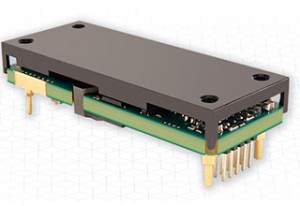 Murata has announced the Murata Power Solutions DBE series of 300 Watt fully regulated digitally controlled DC-DC converters packaged in an industry standard eighth-brick format. The footprint conforms to the Advanced Bus Converter (ABC) Digital standard as specified by the AMP Group industry collaboration. Accommodating the internationally accepted telecommunications network voltage (TNV) standard input range from 36 to 75 Vin and providing a PMBus compliant digital system interface, the DBE series is designed for use in distributed power and intermediate bus applications. A 32-bit ARM processor contains Murata proprietary firmware designed specifically to control and manage the converter’s operation.
Murata has announced the Murata Power Solutions DBE series of 300 Watt fully regulated digitally controlled DC-DC converters packaged in an industry standard eighth-brick format. The footprint conforms to the Advanced Bus Converter (ABC) Digital standard as specified by the AMP Group industry collaboration. Accommodating the internationally accepted telecommunications network voltage (TNV) standard input range from 36 to 75 Vin and providing a PMBus compliant digital system interface, the DBE series is designed for use in distributed power and intermediate bus applications. A 32-bit ARM processor contains Murata proprietary firmware designed specifically to control and manage the converter’s operation.
The DBE series comprises three single output models providing the nominal output voltages of 3.3, 5, and 12 Vout. These highly efficient converters, typically 94.5% efficient (12Vout model), offer basic 2250 VDC isolation as required for some PoE applications. Two or more 12Vout units can be connected in parallel to achieve load sharing for increased Pout or N+1 operation.
The PMBus interface facilitates power management features that allow power system architects great flexibility to control critical operating parameters. By attaching the DBE to the systems I²C bus, an engineer can monitor Vin, Iin, Vout, Iout, and operating temperature. The PMBus can be used to set warning flags for temperature, Vin, Vout, and Iout and allows the user to customize parameters such as Vout, Vin turn on/off thresholds, output over voltage protection, output current limit, and ramp up characteristics to name a few.
A GUI (Graphical User Interface) and evaluation boards are available to assist the power engineer in designing a state of the art power system. Typical applications for the DBE series include MicroTCA, servers, and storage applications, networking equipment, Power over Ethernet (PoE), fan trays, wireless networks, and wireless pre-amplifiers.
Complementing this series of converters is the DVE series, which has the same product characteristics but without the PMBus digital control features.
Features
- Advanced Bus Converter eighth-brick with digital PMBus interface
- Optional standard five-pin eighth-brick
- High efficiency
- Fast dynamic response
- 2250 Vdc input to output isolation voltage
- Voltage droop load sharing for parallel operation
Murata
murata.com


Leave a Reply